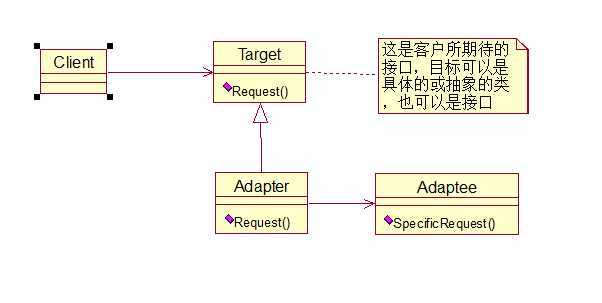标签:blog http io os 使用 ar java strong for
一:结构型模式总结全图:

二:详细解析:

Adapter适配器模式:创建一个接口去使用现成的不兼容的接口的类,主要应用是对系统维护添加新功能时。
使用过程:给要使用的对象提供一个访问接口,使得目标对象功能整合到系统中。
生活实例:简单典型的就是电脑笔记本电源
2. Proxy代理模式

Proxy代理模式:用代理对象来控制对原有对象的引用,其接口不可以改变。
3. Decorator装饰模式图

public class Test
{
public static void main(String[] args)
{
ErrorLog errorLog = new ErrorLog();
DecorateLog errorLogAbove = new DecorateLog(errorLog);
System.out.println("errorLogAbove:");
errorLogAbove.printMessage();
DubugLog dubugLog = new DubugLog();
DecorateLog dubugLogAbove = new DecorateLog(errorLogAbove, dubugLog);
System.out.println("dubugLogAbove:");
dubugLogAbove.printMessage();
InforLog inforLog = new InforLog();
DecorateLog inforLogAbove = new DecorateLog(dubugLogAbove, inforLog);
System.out.println("inforLogAbove:");
inforLogAbove.printMessage();
}
}
abstract class Log
{
public abstract void printMessage();
}
class DecorateLog extends Log
{
Log log1;
Log log2;
public DecorateLog()
{
}
public DecorateLog(Log log1)
{
this.log1 = log1;
}
public DecorateLog(Log log1, Log log2)
{
this.log1 = log1;
this.log2 = log2;
}
public void printMessage()
{
if (null != log1)
log1.printMessage();
if (null != log2)
log2.printMessage();
}
}
class ErrorLog extends Log
{
public void printMessage()
{
System.out.println("Error Information");
}
}
class DubugLog extends Log
{
public void printMessage()
{
System.out.println("DubugLog Information");
}
}
class InforLog extends Log
{
public void printMessage()
{
System.out.println("InforLog Information");
}
}
Decorator装饰模式:为目标对象动态添加一些新的操作和功能。
4.外观模式图

Facade外观模式:对系统屏蔽子系统的组件,降低客户端和系统内部的耦合。
生活实例:发短信查话费。项目中应用为数据库方面。(DataUtil类的实现就是Facade)
5.桥接模式图

Bridge桥接模式:将系统的抽象与实现分离,有利于分层架构的实现。减少因变化带来的代码修改。
package com.test.Bridge;
public class Test
{
public static void main(String[] args)
{
AbstractRoad Road1 = new SpeedWay();
Road1.car = new Car();
Road1.Run();
}
}
abstract class AbstractCar
{
public abstract void Run();
}
class Car extends AbstractCar
{
public void Run()
{
System.out.println("小汽车在");
}
}
class Bus extends AbstractCar
{
public void Run()
{
System.out.println("公共汽车在");
}
}
abstract class AbstractRoad
{
AbstractCar car;
public abstract void Run();
}
class SpeedWay extends AbstractRoad
{
public void Run()
{
car.Run();
System.out.println("高速公路上行驶");
}
}
class Street extends AbstractRoad
{
public void Run()
{
car.Run();
System.out.println("市区街道上行驶");
}
}
生活实例:设备开关
6.组合模式图

Composite组合模式:使得用户对对象使用具有一致性
在结构上和decorate很想,通常情况两种模式是一起实现的
package com.test.Composite;
import sun.reflect.generics.reflectiveObjects.NotImplementedException;
import java.util.*;
public class Test
{
public static void main(String[] args)
{
// 构造根节点
Composite rootComponent = new Composite("root");
// 添加两个叶子几点,也就是子部件
Leaf leaf1 = new Leaf("leaf1");
Leaf leaf2 = new Leaf("leaf2");
rootComponent.add(leaf1);
rootComponent.add(leaf2);
// 遍历组合部件
rootComponent.eachChild();
}
}
abstract class Component
{
String name;
public String getName()
{
return name;
}
public void setName(String name)
{
this.name = name;
}
// 添加部件
public abstract void add(Component component);
// 删除部件
public abstract void remove(Component component);
// 遍历所有子部件
public abstract void eachChild();
}
class Leaf extends Component
{
public Leaf()
{
}
public Leaf(String name)
{
this.name = name;
}
// 叶子节点不具备添加的能力,所以不实现
public void add(Component component)
{
throw new NotImplementedException();
}
// 叶子节点不具备添加的能力必然也不能删除
public void remove(Component component)
{
throw new NotImplementedException();
}
// 叶子节点没有子节点所以显示自己的执行结果
public void eachChild()
{
String str = String.format(name+"执行了..");
System.out.println(str);
}
}
class Composite extends Component
{
public Composite()
{
}
public Composite(String name)
{
this.name = name;
}
// 用来保存组合的部件
List<Component> myList = new ArrayList<Component>();
// 添加节点 添加部件
public void add(Component component)
{
myList.add(component);
}
// 删除节点 删除部件
public void remove(Component component)
{
myList.remove(component);
}
// 遍历子节点
public void eachChild()
{
String str = String.format(name+"执行了..");
System.out.println(str);
for (Component c : myList)
{
c.eachChild();
}
}
}
7.享元模式

享元模式:运用共享技术有效的支持大量细粒度的对象

标签:blog http io os 使用 ar java strong for
原文地址:http://www.cnblogs.com/liule1225/p/3998414.html